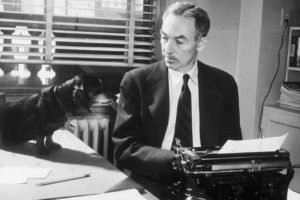E.B. White and his Greenwich Village
When people hear the name E.B. White, most immediately think of the much-adored children’s’ classics, Charlotte’s Web, Stuart Little, and Trumpet of the Swan. However, his work extended far beyond that genre, and his literary “hats” included essayist, novelist, humorist, and poet (although he described himself as a “non-poet who occasionally breaks into song”). Like so many literary giants, White made Greenwich Village his home, in his case during the 1920s, 30s, and 40s, when the Village was brimming with young artists, poets, novelists, and critics.

New York Times Co.
Elwyn Brooks White (July 11, 1899 — October 1, 1985) was born in Mount Vernon, New York, the youngest of six children. He graduated from Cornell University in 1921. He moved to New York in 1925 and took up residence with three of his Cornell fraternity brothers, renting an apartment at 112 West 13th Street. In E.B. White: A Biography by Scott Elledge, White is quoted as describing these years in Greenwich Village, particularly the summer of 1925 until the winter of 1926-27, as “lean and tortured,” a lonely period during which he endured “comparative unemployment,” working part-time for an advertising company. Nevertheless, he also considered this the “only genuinely creative period” of his life, as he had plenty of time to write and explore the city. Success began for the young writer when had several submissions to the then-new New Yorker magazine published, one of which, ‘Child’s Play,’ was particularly well received.

After a couple more successful submissions by White to the magazine, its literary editor, Katharine Angell recommended to editor-in-chief and founder Harold Ross that White be hired as a staff writer. White was reluctant at first to commit to a desk job, even as a writer. Eventually he consented, and became The New Yorker’s weekly contributing editor. White had a tremendous influence on the form, tone, and success of the burgeoning magazine, one of the most influential American literary magazines in the mid-20th century, and his contributions to the magazine would span nearly 60 years.

1929 was a busy year for White. He published a poetry collection, The Lady is Cold, and with fellow New Yorker magazine writer James Thurber co-authored a parody of books on Freudian psychology, Is Sex Necessary? White also married Katharine Angell in 1929, the editor at The New Yorker a who had recommended White for the staff writer position and a divorcee with two children. Following the wedding, White moved from his place on West Twelfth Street to her apartment 16 East 8th Street. Shortly after moving in, they increased their third floor, three-room space by renting the apartment directly above and installing an interior stairway between the two. In 1933 the Whites bought a farm in Maine which would serve them and their children as a second home.
By 1935, the Whites required more room than their six-room apartment on East 8th Street afforded, and moved to Turtle Bay Gardens, an artists enclave in the East 40s (White was however less than enthusiastic about leaving the Village). In 1944 the Whites came back to Greenwich Village to a furnished apartment on West 11th Street. Within a week of being back in his beloved Village, he wrote Village Revisited (A Cheerful lament in which truth, pain, and beauty are prominently mentioned, and in that order) writing:
Beauty recalled me. We bowed in the Square,
In the wonderfully westerly Waverly air.
She had a new do, I observed, to her hair.
Within eight weeks of moving back to the Village, he completed the manuscript for Stuart Little (his first children’s book) which he had been working on for years. The book was published in 1945, and by the end of the following year, 105,000 copies had been printed (by 1977, 2.5 million copies had been sold). In 1946, the Whites moved back to Midtown, and eventually took up full-time residence at their farm in Maine.

In 1948, White wrote one of his most famous essays and best pieces on New York City, “Here is New York.” Originally written for Holiday Magazine, it was published in book version in 1949. He wrote it from the Algonquin Hotel during a summer visit to the city. If you haven’t read it or re-read it in a while, I recommend doing so. It offers its reader a window into post-World War II New York City; while some of the observations are very much of that time, some are timeless to New York City.
In 1952 White published Charlotte’s Web (published October 15th, 1952), placing him in the Pantheon of beloved children’s authors. In 1959 he along with his former Cornell professor William S. Strunk, Jr. collaborated on The Elements of Style, offering both rules of grammar and advice in writing style; this became a permanent fixture on College campuses for decades to come.
White received the National Medal for Literature in 1971, and two years later was elected to the American Academy of Arts and Letters. He was honored with the National Medal for Literature, a special Pulitzer award, and the Laura Ingalls Wilder Medal. White died of Alzheimer’s Disease in 1985 in Maine.
White is one of many great writers of the Village, and if you want to see where more lived, you can take our Homes of Great Writers tour on our Greenwich Village Historic District 50th Anniversary map — click HERE.
